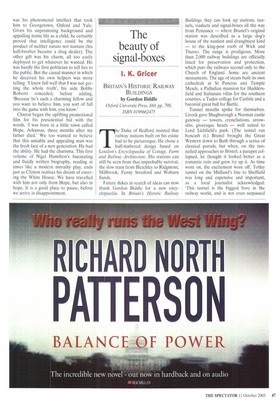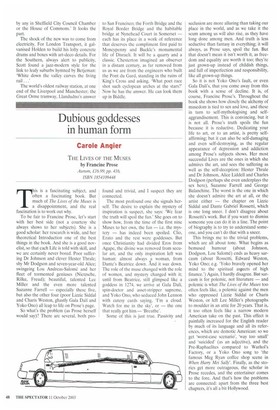The beauty of signal-boxes
I. K. Gricer
BRITAIN'S HISTORIC RAILWAY BUILDINGS by Gordon Biddle Oxford University Press, £60, pp. 798, ISBN 0198662475 The Duke of Bedford insisted that railway stations built on his estate had to be picturesque. He chose a half-timbered design based on Loudon's Encyclopaedia of Cottage, Farm and Railway Architecture. His stations can still be seen from that improbable survival, the slow train from Bletchley to Ridgmont, Millbrook, Fenny Stratford and Woburn Sands.
Future dukes in search of ideas can now thank Gordon Biddle for a new encyclopaedia. In Britain's Historic Railway
Buildings they can look up stations, tunnels, viaducts and signal-boxes all the way from Penzance — where Brunel's original station was described as a large dog's house of the nastiest and draughtiest kind — to the king-post roofs of Wick and Thurso. The range is prodigious. More than 2,000 railway buildings are officially listed for preservation and protection, which puts the railways second only to the Church of England. Some are ancient monuments. The age of steam built its own cathedrals at St Pancras and Temple Meads, a Palladian mansion for Huddersfield and Italianate villas for the southern counties, a Tudor college for Carlisle and a baronial great hall for Battle.
Tunnel mouths spoke for themselves. Livock gave Shugborough a Norman castle gateway — towers, crenellations, arrowslits, grotesque heads — well suited to Lord Lichfield's park. (The tunnel ran beneath it.) Brunel brought the Great Western down to Bath through a series of classical portals, but when, on the tunnelled approaches to Bristol, a parapet collapsed, he thought it looked better as a romantic ruin and grew ivy up it. As time wore on, the excitement wore off. Totley tunnel on the Midland's line to Sheffield was long and expensive and important, as a local journalist acknowledged: 'This tunnel is the biggest bore in the railway world, and is not even surpassed by any in Sheffield City Council Chamber or the House of Commons.' It looks the part.
The shock of the new was to come from electricity. For London Transport, it galvanised Holden to build his lofty concrete drums and boxes with art-deco details. For the Southern, always alert to publicity, Scott found a jazz-modern style for the link to leafy suburbs hymned by Betjeman: 'White down the valley curves the living rail ...'
The world's oldest railway station, at one end of the Liverpool and Manchester; the Great Orme tramway, Llandudno's answer to San Francisco; the Forth Bridge and the Royal Border Bridge and the habitable bridge at Nynehead Court in Somerset — each has its place in a work of reference that deserves the compliment first paid to Moneypenny and Buckle's monumental life of Disraeli. It will be a quarry and a classic. Chesterton imagined an observer in a distant century, as far removed from us as we are from the engineers who built the Pont du Gard, standing in the ruins of King's Cross and asking, 'What poet race shot such cyclopean arches at the stars?' Now he has the answer. He can look them up in Biddle.



















































































 Previous page
Previous page